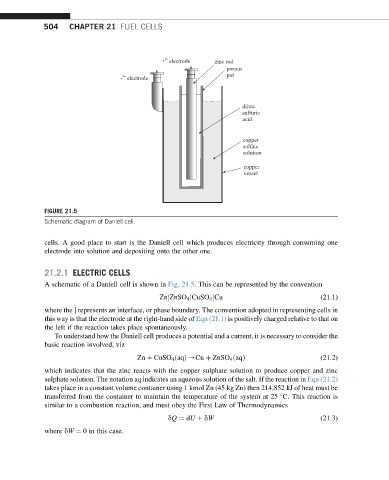Page 511 - Advanced thermodynamics for engineers
P. 511
504 CHAPTER 21 FUEL CELLS
+ electrode zinc rod
porous
pot
- electrode
dilute
sulfuric
acid
copper
sulfate
solution
copper
vessel
FIGURE 21.5
Schematic diagram of Daniell cell.
cells. A good place to start is the Daniell cell which produces electricity through consuming one
electrode into solution and depositing onto the other one.
21.2.1 ELECTRIC CELLS
A schematic of a Daniell cell is shown in Fig. 21.5. This can be represented by the convention
ZnjZnSO 4 jCuSO 4 jCu (21.1)
where the j represents an interface, or phase boundary. The convention adopted in representing cells in
this way is that the electrode at the right-hand side of Eqn (21.1) is positively charged relative to that on
the left if the reaction takes place spontaneously.
To understand how the Daniell cell produces a potential and a current, it is necessary to consider the
basic reaction involved, viz
Zn þ CuSO 4 ðaqÞ/Cu þ ZnSO 4 ðaqÞ (21.2)
which indicates that the zinc reacts with the copper sulphate solution to produce copper and zinc
sulphate solution. The notation aq indicates an aqueous solution of the salt. If the reaction in Eqn (21.2)
takes place in a constant volume container using 1 kmol Zn (45 kg Zn) then 214,852 kJ of heat must be
transferred from the container to maintain the temperature of the system at 25 C. This reaction is
similar to a combustion reaction, and must obey the First Law of Thermodynamics
dQ ¼ dU þ dW (21.3)
where dW ¼ 0 in this case.

